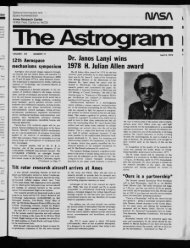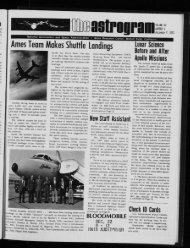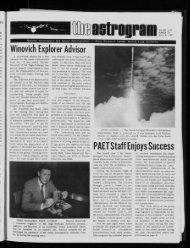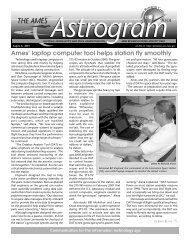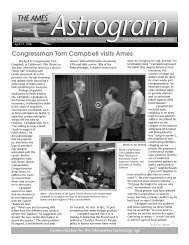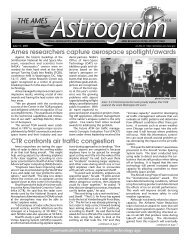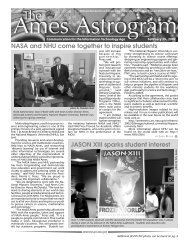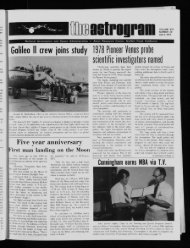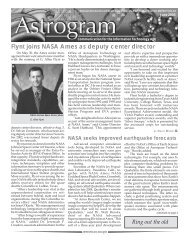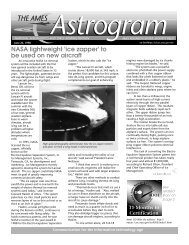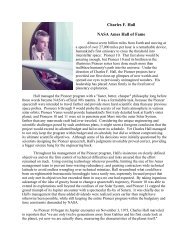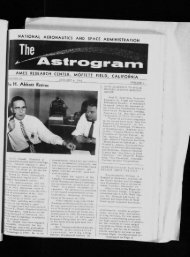Innovative partnership to revolutionize NASA supercomputing
Innovative partnership to revolutionize NASA supercomputing
Innovative partnership to revolutionize NASA supercomputing
Create successful ePaper yourself
Turn your PDF publications into a flip-book with our unique Google optimized e-Paper software.
Ames Safety Awards Program<br />
-- second trimester awards presented<br />
Under the Ames Safety Awards Program<br />
(ASAP) II, Ames recognized 40<br />
employees for their outstanding accomplishments<br />
in improving health and<br />
safety. ASAP II was established <strong>to</strong> recognize<br />
employee actions, behavior and/<br />
or job performance that result in improved<br />
health and safety conditions at<br />
the center.<br />
There are four levels of awards, with<br />
tier four being the highest level of<br />
achievement. The ASAP II board evaluates<br />
each nomination and selects the tier<br />
level that best represents the actions and<br />
accomplishments of that nomination.<br />
A group of nine individuals from<br />
the Bionetics Corporation received this<br />
trimester’s highest team award. They<br />
were recognized for their effort in establishing<br />
and maintaining a safe working<br />
environment, commitment <strong>to</strong> continuous<br />
safety improvements, the accomplishments<br />
of the Animal Care Facility<br />
Safety Committee and over four years of<br />
work without a reportable mishap.<br />
Tier Level 3 – Individual awards<br />
Sergio Castellanos, Stuart Jaquez<br />
Tier Level 2 – Individual awards<br />
Bryan Biegel, Joe Gippetti,<br />
Fred Jones, Nicholas Scott, Jon<br />
Talbot<br />
Tier Level 2 – Team awards<br />
Improving the Safety in the<br />
Animal Care Facility:<br />
Edwin Agustin, Juan Calderon,<br />
Jose Casem, Danielle Galindo,<br />
David Garcia, Anthony Johnson,<br />
Raymond Montuya, Cathy<br />
Nguyen, Carolyn Reed<br />
Tier Level 1 – Individual awards<br />
Peteris Graube, Bill Lee,<br />
AC Mosher<br />
Tier Level 1 – Team awards<br />
Design and Construction<br />
of Safety Upgrades <strong>to</strong> Various<br />
Buildings:<br />
Szuchuan Chang, Vic<strong>to</strong>r Coquilla,<br />
William Lee, XinXin Nee,<br />
Raymond Schuler<br />
Employee Involvement in<br />
Improving Safety in the Division:<br />
Desiree Barrien<strong>to</strong>s, Lena Contreras,<br />
Dana Davidson, Myrna Espinosa,<br />
Mary Perez, Lita Que<br />
Evacuation of N241 Basement:<br />
Lena Contreras, Dana Davidson,<br />
Kristie Dunbar, Lynette Forsman,<br />
Michael Forsman, Lourdes<br />
Hammett, Gail James,<br />
Diane Kanally, Mary Perez,<br />
Lita Que<br />
Each of these employees and teams<br />
was nominated by their colleagues for<br />
their outstanding actions and accomplishments<br />
in improving health and<br />
safety conditions at Ames.<br />
Turtle survey<br />
continued from page 5<br />
ronmental Protection Agency’s National<br />
Environmental Performance Track<br />
(NEPT) program. NEPT is a voluntary<br />
<strong>partnership</strong> comprised of public and<br />
private organizations designed <strong>to</strong> encourage<br />
members <strong>to</strong> go beyond compliance<br />
with regula<strong>to</strong>ry requirements <strong>to</strong><br />
proactively implement beneficial environmental<br />
programs. Through this program,<br />
<strong>NASA</strong> Ames has committed <strong>to</strong><br />
increase western pond turtle habitat by:<br />
1) setting out basking logs on which the<br />
turtles can sun themselves; 2) conducting<br />
habitat maintenance that includes<br />
mowing, creating pools and pulling cattails<br />
in the ditches; and, 3) providing<br />
protection from ongoing activities.<br />
<strong>NASA</strong> Ames plays an important role<br />
in fostering western pond turtle growth<br />
in the Bay area. The <strong>NASA</strong> Ames habitat<br />
is unique in that it is the only western<br />
pond turtle habitat in the area with<br />
purely western pond turtles. In comparison,<br />
other bodies of water in this<br />
lower river system, such as the San<br />
Tomas Aquino Creek, Guadalupe River<br />
and the Calabazas Creek, all have a combined<br />
population of the western pond<br />
turtle with the non-native red-eared<br />
slider species that is commonly found in<br />
pet s<strong>to</strong>res. The red-eared slider is considered<br />
detrimental <strong>to</strong> the western pond<br />
turtle because it will out compete the<br />
western pond turtle and further contribute<br />
<strong>to</strong> its population decline.<br />
Thanks <strong>to</strong> the knowledge obtained<br />
through the surveys, Alderete forecasts<br />
the continued growth of the western<br />
pond turtle population at <strong>NASA</strong> Ames.<br />
BY STACY ST. LOUIS<br />
Saturn’s rings<br />
continued from page 7<br />
face. Huygens' descent will take about<br />
three hours, give or take 30 minutes.<br />
Huygens was built by ESA, but the first<br />
studies of Titan entry probes were done<br />
at Ames in the 1970s and 1980s. The<br />
probe will collect aerosol and surface<br />
data, and Ames scientists Chris McKay<br />
and Bill Borucki will study those results<br />
as mission co-investiga<strong>to</strong>rs.<br />
Cassini will complete 74 orbits over<br />
its four-year nominal mission, changing<br />
its course by using 44 more close flybys<br />
of Titan - each 10 times closer than the<br />
recent first one - and using its telescopes,<br />
radar and other instruments <strong>to</strong> study<br />
Titan's surface and atmosphere further.<br />
During the <strong>to</strong>ur, the spacecraft will conduct<br />
more than a dozen 1000-kilometer<br />
flybys of Saturn's icy satellites. Dale<br />
Cruikshank of Ames, who specializes in<br />
satellite composition - in particular their<br />
organic molecules - will be closely involved<br />
in interpreting these results.<br />
The Cassini mission has been extended<br />
two additional years and, if all<br />
goes well, will run through 2009. The<br />
end-of-mission plan is for Cassini <strong>to</strong><br />
ultimately be pushed in<strong>to</strong> Saturn, as<br />
Galileo dove in<strong>to</strong> Jupiter's atmosphere<br />
when its mission ended, or <strong>to</strong>ward one<br />
of the rings where it will collide and<br />
become just another ring particle.<br />
BY KATHLEEN BURTON<br />
Ralph W. Lewis<br />
passes away<br />
Ralph Lewis of San Jose passed<br />
away in May. Lewis was born in Salt<br />
Lake City, Utah and lived in San Jose<br />
for 35 years. Lewis managed the<br />
technical information services branch<br />
at <strong>NASA</strong> Ames and later worked in<br />
the same capacity for Lockheed. In<br />
retirement, Lewis enjoyed dancing,<br />
writing and travel.<br />
Lewis was widowed by his wife<br />
of 48 years, Dorothy lewis, in 2000<br />
and was predeceased by his daughter<br />
Amy Lynn Lewis in 2001. He is<br />
survived by his daughter Shelley<br />
Boose of San Jose and his son, Mark<br />
Lewis of Phoenix. He leaves behind<br />
five grandchildren, three sisters and<br />
numerous nieces, nephews and cousins.<br />
He will be deeply missed.<br />
11<br />
Astrogram August 2004



